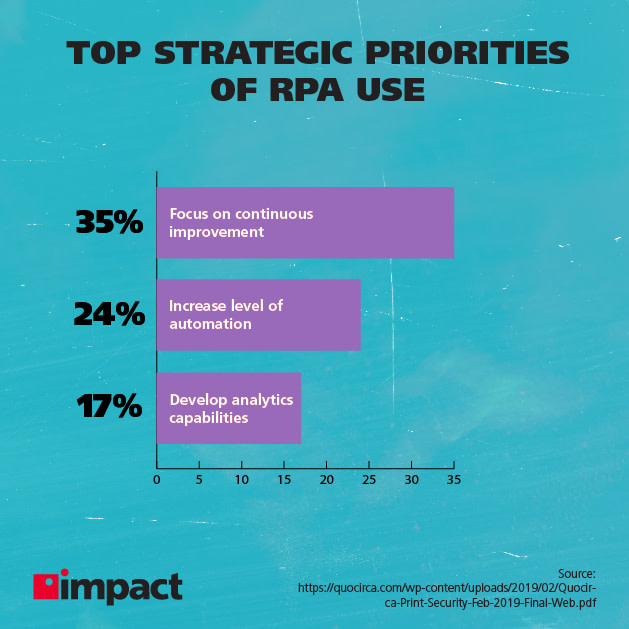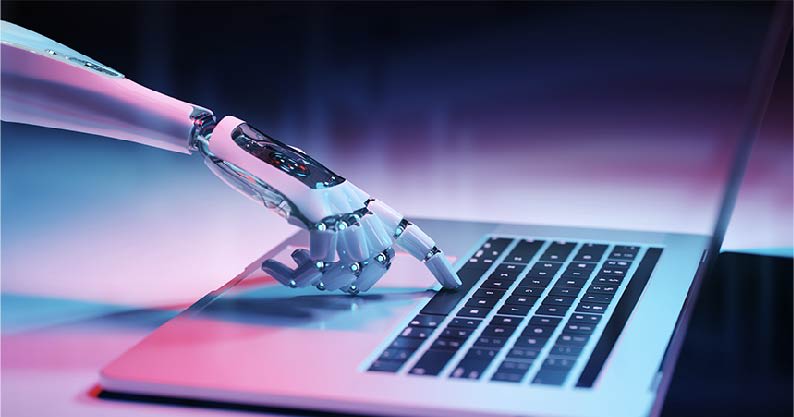Understanding What the Role of RPA is for Business
What is RPA?
If you’re already having a hard time getting your head around the litany of three-letter acronyms that have arisen from digital transformation in the past few years, robotic process automation (RPA) might seem like just another one for the heap.
Don’t be fooled, however—this really is one worth remembering for the future.
RPA is business process automation (BPA) that allows bots to take over several complex processes, such as data handling and customer service, while applying machine learning to give a distinctly human touch to automated processes.
Your “bots” are software programs specifically designed to take on specific and varied tasks such as data entry, data extraction, candidate sourcing, and payroll automation.
You can assign and control bots to tackle processes—often time-consuming and monotonous—and free up time for staff to handle other projects.
Applications of RPA
The Tasks and Uses of RPA Bots
- Data extraction – large amounts of data can be trawled
- Data management – data aggregation and curation
- Operational activities – logistics and operational support
- Procure-to-pay – invoice processing and reporting
- Inventory and supply chain – categorization and management
The Different Types of RPA Technology
Which RPA Tools Are Options for Your Business?
With an estimated 80 million jobs in the US deemed suitable candidates for automation, it should come as no surprise that there is a real and urgent need to adopt solutions that can address these needs.
RPA comes in different forms, typically revolving around three forms of bots:
Attended RPA
Typically, frontend bots that work with humans, attended RPA assists in repetitive tasks when triggered by the user.
It is often in a passive state until called upon, wherein it can quickly achieve menial tasks while workers can focus on other important processes that necessitate a human touch.
The key aspect of attended RPA is that it only works on a “‘trigger”, that is to say, on the command of a human.
Whether that is immediate, a scheduled use at specific time, or on the completion of a certain condition, humans are the ones who exclusively dictate the use of attended bots on their command.
Common examples of attended automation would be data gathering from several databases and departments while dealing with a customer inquiry or assisting in manual data entry by retrieving and copying and pasting information, for example.
Benefits of attended RPA bots
- Requires human intervention to begin an automated process, which is useful for oversight purposes and compliance
- Often hosted on a specific workstation or server, and permitted to perform a designated task
- Easy to use and user-friendly for employees working across multiple screens. For staff in a customer-facing role, this can be a big advantage—while they’re dealing with any number of queries, the bot can be activated to perform its task. In other words, it’s one less thing to think about for staff
- Doesn’t disrupt existing processes—attended bots aren’t necessarily created to change a process, just to do it more quickly and efficiently, saving time and money for the employee typically assigned the task
Unattended RPA
These bots work in a similar method of acting on triggers, but do not have to be manually triggered by humans when performing a task.
Unattended bots are typically in a constant state of readiness until they are compelled to operate.
Unattended bots work in the background and will continuously and automatically perform their assigned task without the intervention of a worker.
Because they require no aid by employees, these bots are extremely useful for automating back-end office tasks and streamlining workflows within a company.
Expect to find these RPA solutions auto-sending emails after customer purchases; automatically processing online applications; and receiving and entering organization-wide data, improving efficiency, accuracy, and speed for many clerical functions
Benefits of unattended RPA
- 24/7/365—unattended bots don’t need to be actively trigged by a human, allowing them to perform their task around the clock for as long as the server it lives on has power
- Unattended bots can be triggered by themselves or other software programs
- Can be accessed remotely
- Can be scaled for large-scale operations—one of the most popular uses of unattended RPA is the aggregation, sorting, and storing of masses of data
Hybrid RPA
This form of RPA is a combination of both attended and unattended RPA bots, working in tandem together.
RPA bots are not either/or solutions and using them together in a hybrid system is often a great way to optimize workflows and achieve a smooth operation from your bots.
For example, a worker can begin a task with attended automation, which will in turn operate unattended bots to perform any tasks it needs to complete.
These hybrid solutions most often take the form of facilitating front- and back-office processes. As we discussed earlier, a business might invest in an attended RPA bot to support its customer service operations, while at the same time using unattended bots to go through customer data that can be retrieved by an employee from the cloud whenever they wish to do so.
Potential for Digital Transformation for SMBs
How RPA is Influencing Digital Transformation in Business
As RPA becomes an ever-increasing fixture for the future of business, digital transformation strategies are consistently looking towards incorporating bots into their solutions to prepare for DX.
Decision makers are increasingly keen to implement RPA in their organizations, with up to 40% of larger enterprises adopting some kind of RPA software by next year, up from 10% in 2018
While in the digital transformation space, it’s easy for businesses to get bogged down and make tech investments they don’t need, RPA is a solution that increasingly looks as though even modest SMBs should be keeping an eye on to see if they can utilize it for their work processes.
In a study, it was noted that companies got a return of between 30% to 200% on RPA investments.
Granted, that’s a large disparity, but what seems clear at the moment is that investments so far seem to prove successful for SMBs, with most of them seeing a positive return on adoption.
It’s worth acknowledging that it can be difficult to put a number on ROI from RPA—one of the reasons studies tend to throw out varying figures.
This is mostly because investment in bots might not provide an instant ROI, but like a lot of digital transformation projects, it’s the secondary effects that end up paying off.
With regards to bots, this will typically be found in the workloads of employees. Companies deploying RPA solutions should measure their success by asking employees what their experiences are with them.
Are they helping them do particular aspects of their job more quickly? Are they able to spend more time on tasks that need a human to perform them? Are they more satisfied in their role now they don’t have to perform a time-consuming and menial task? Are they able to access and retrieve aggregated data more effectively?
These are where the positives of RPA come to fruition for most businesses.
That’s a significant leap for an emerging technology, though with SMBs adoption is somewhat slower.
An automation strategy requires a significant investment over a long period of time.
With RPA now readily available to businesses of all sizes, having a plan for future automation in your business is an important consideration to make for your digital transformation strategy.
Bottom Line
The market for RPA has been growing rapidly over the last half of the 2010s and is shaping up for even bigger years ahead. From 2020 to 2027, it is anticipated that the market will grow at a CAGR of 34%, an even faster rate than previous years.
The reason for this increased implementation by businesses is for a few primary reasons—firstly, these solutions are readily accessible in a way they haven’t been in the past. Secondly, SMBs are recognizing that it’s not just large corporations that are investing in new tech, but their direct, local competitors too.
Because of this, it’s become important for even small SMBs to be aware of and, where necessary, seek to install bots that can aid their operations effectively.
RPA can be easily incorporated into a wider digital transformation strategy; for example, as part of a document management solution. As a result, RPA is more sought-after than ever and will continue to be an important part of technology adoption plans by organizations going forward.
Learn More About What RPA Means for the Future
Robotic process automation helps companies achieve and maintain a competitive advantage in their industry. Through leveraging the tools available, which increase staff productivity and decrease costs, companies can enjoy higher operating capacity while delivering superior customer experience.
RPA is just one aspect of digital transformation which is changing the way small businesses operate in today’s constantly evolving landscape. Learn more about how you can modernize your organization with our robotic process automation (RPA) services.



